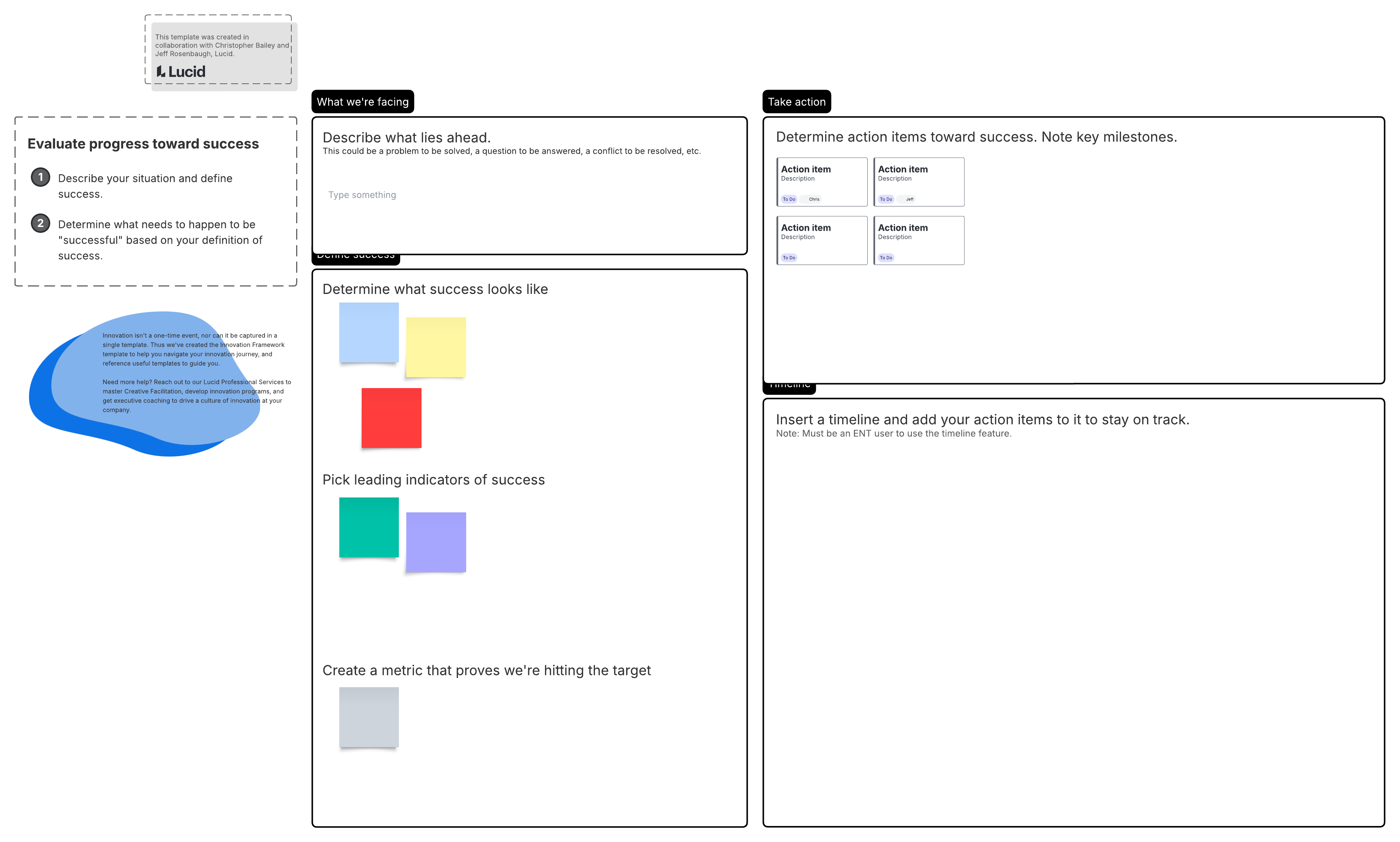
How to measure collaboration in the workplace (+ the most meaningful collaboration metrics)
Christopher Bailey
Reading time: about 14 min
Topics:
Key takeaways
- Measuring collaboration drives strategic decisions, promotes accountability, leads to continuous improvement, and helps show ROI to justify future investments.
- The first step to measuring collaboration is defining what effective collaboration looks like for your organization, including key behaviors and outcomes.
- Collaboration cannot be measured with a single metric. Pair leading metrics, such as number of meetings, with lagging metrics, such as faster time to value or reduced costs, to understand impact.
- You can measure time, cost, efficiency, engagement, visibility, and alignment. Examples of collaboration metrics include time in meetings, percentage of projects that meet deadlines, travel cost reductions, and contributions in shared repositories.
Most leaders I talk to struggle to capture meaningful collaboration metrics—you know, the kind that actually inform decisions, not just elicit a warm, fuzzy feeling.
Take office attendance or tool usage, for instance. These metrics are easy to track and can often present a satisfying upward trend. But what do these basic metrics reveal about the quality and impact of collaboration? In most cases, not much.
Unfortunately, when vanity metrics like these are the only metrics used, collaboration isn’t seen as the core business driver it is. And that’s a shame when it’s so tightly linked to improving efficiency, innovation, product development, customer satisfaction, and the bottom line.
While leading the consulting services team at Lucid, I’ve helped dozens of organizations measure, improve, and show the impact of collaboration in the workplace. My goal is to help you do the same. In this article, I’ll share the strategies I’ve seen work best for measuring collaboration success and provide examples of metrics you can use to show the real value of collaboration.
Why should you measure collaboration?
Most teams wouldn’t launch a new product or a marketing campaign without solid data to back it up, yet collaboration is too often driven by intuition, guesswork, or simply incomplete metrics.
Meaningful collaboration metrics are so crucial to a business because they:
-
Drive strategic decisions: The right metrics help you pinpoint the areas of your collaboration strategy (people, process, or technology) that need the most attention. They also allow you to ensure that any changes you make have the desired impact without negatively impacting other areas in the organization. Without meaningful collaboration metrics, for example, you could remove a tool to save money but unintentionally cause a productivity dip that completely offsets the savings.
-
Promote accountability and motivation: When you can clearly define and measure collaborative success, you give your teams a clear target to work toward. In this sense, collaboration metrics naturally lead to behavior change that benefits teams.
-
Justify investment: Showing a clear return on investment (ROI) is essential for getting buy-in for future projects. By connecting collaboration initiatives to tangible business outcomes, you can make a powerful case for continued investment.
-
Lead to continuous improvement: When you can measure collaboration, you can improve it. And when you improve collaboration, you help the business reach its goals faster. Whether you’re trying to increase efficiency, boost agility and innovation, or lower costs, collaboration is a critical component.
How to measure collaboration: Strategies for capturing meaningful metrics
Moving beyond surface-level metrics requires a more thoughtful approach. Here are four strategies to help you capture those harder-to-come-by but infinitely more valuable collaboration metrics.
Strategy #1: Define what successful collaboration means to your org
You can’t measure collaboration if you don’t know what successful collaboration actually looks like for your organization. Start by defining the behaviors you’d expect to see during optimal collaboration and the business outcomes that would result from those behaviors. Essentially, your goal is to define the "evidence" of effective collaboration.
Then, you can assign each behavior a metric, or a numerical value you’ll track to determine how well your team is exhibiting that behavior. From there, you can tie behavior metrics into broader business outcomes like increased productivity or reduced costs.
The key here is to be as specific as possible. For example, let’s say you think good collaboration should equate to time savings. That’s a fine starting point, but in order to identify meaningful collaboration metrics, you need to get more specific as to what collaborative behaviors would lead to time savings.
Maybe you’d expect that teams would spend less time on certain activities, such as reaching consensus or making decisions. In this case, you’d want to measure the percentage of time spent in meetings making decisions. This is a clear metric that you can measure and track over time.
It’s important to validate the metrics you assign to behaviors with leadership before you start measuring them. Sometimes these connections are a leap of logic, and you could end up measuring something that doesn’t resonate with stakeholders.

Strategy #2: Establish a baseline to track progress
Once you've identified the behaviors that indicate effective collaboration, you can start collecting data to create a baseline. This step will help you identify areas for improvement and set clear collaboration KPIs (key performance indicators) with specific targets.
You can measure your current state in several ways:
-
Surveys: Team feedback is an excellent starting point for getting a high-level understanding of collaboration strengths and weaknesses. To collect this feedback, you can send out a survey like Lucid’s collaboration assessment. Once you start noticing trends (e.g., 60% of teams report not knowing where to find key project info), you can focus on identifying the root cause and making an action plan.
-
Process maps: Another way to capture baseline metrics is to map out common workflows and processes (e.g., a new customer onboarding process or a new product launch workflow). I recommend adding data to your diagrams with an intelligent visual collaboration solution like Lucid to easily see which steps take the longest or are the most inefficient.
-
Existing metrics: Because collaboration affects nearly every aspect of business, it makes sense that many project metrics you’re already tracking could also be used to measure the effectiveness of collaboration. For instance, maybe you’re already tracking the engineering team’s velocity or the completion rate of certain projects. As collaboration improves within these teams, so should these existing metrics.
Once you have baseline data, you can create dashboards and set up regular review conversations to hold people accountable for the results you're looking for. Take some time to identify the core stakeholders who need to review collaboration metrics. Maybe it's all of IT leadership, a subset of the IT team, or even a cross-section of leaders across business and IT.

Strategy #3: Tie metrics to impact, not just usage
Usage metrics—like the number of comments on a thread or meeting room bookings—don’t provide much insight without context. On their own, they tell you about the quantity of collaborative activities, not the quality.
These metrics aren’t necessarily bad to measure, but they do need to be tied to a goal to be useful. Let’s say, for instance, you have a hypothesis that bringing people together in the office will spark more innovative ideas. In this case, measuring the office attendance rate alone wouldn’t give you much insight. Sure, more people may be in the office, but how do you know if this is actually leading to the desired outcome? You’d need to identify key innovation metrics to track alongside office attendance to show any correlation to your goal.
Collaboration is complex, and it’s simply not possible to measure it with a single metric. To show the actual impact of collaboration, you’ll want to pair leading metrics (your basic usage metrics) with lagging metrics, such as faster time to value, reduced costs, or improved customer satisfaction, to name just a few.
Let me give you an example of how Lucid’s professional services team combined leading and lagging metrics to show the value of collaboration for a major insurance provider. My team piloted a program with the hypothesis that the organization could improve meeting efficiency, one of its strategic objectives, by increasing asynchronous collaboration.
To test our hypothesis, we needed both leading metrics to show an increase in asynchronous collaboration and a lagging metric to measure meeting efficiency, the intended outcome of asynchronous collaboration in this case. Here are the metrics we used:
-
Leading metrics: The number of documents created per user, the number of documents owned by the team, and the number of edits and shares per document, measured over the span of a quarter
-
Lagging metric: The difference between the time spent in meetings at the beginning of the quarter compared to the end
Neither of these metrics would have given us much direction on its own, but together, they showed that as asynchronous activity increased, meeting efficiency also increased. Of course, there may be other factors that could also contribute to the increase in efficiency here, but it’s not necessary (and not typically feasible) to prove a 1:1 correlation. What’s important is that there is a correlation that we can attempt to replicate or scale in other parts of the business.
Strategy #4: Use qualitative data to tell the full story
As much as I rave about quantitative data, it’s not enough on its own to truly understand the impact of collaboration. You need to supplement it with qualitative context that tells a clear story. I encourage leaders to show the impact by painting a picture of the "before" and "after” situation, using not just numbers but also specific examples of how behaviors have changed.
Include quotes from interviews, feedback from surveys, and other observed changes to tell your story. Making this connection clear helps show the value of all the effort you’re putting into optimizing collaboration.
Here’s an example from a leading supermarket chain Lucid worked with:
Before using Lucid to collaborate, the service quality team’s work was spread across tools, making it difficult and time-consuming for team members to find the most up-to-date information.
After implementing Lucid, the team saved two hours every week due to better alignment and access to a single source of truth for audit plans, process maps, and project updates. One team member said, “With Lucid, our team can collaborate and get feedback so much faster. We can iterate in real time, which cuts out a lot of back-and-forth and unnecessary delays."
In this example, the qualitative narrative shows what specific behaviors changed (in this case, how the team accessed and shared information) that led to the time savings of two hours per week. The quote adds even more color, and the detail makes the entire example easier to replicate across teams.
Meaningful collaboration metrics to consider
The success metrics you use will vary depending on your organization’s unique goals. With that said, I’ll share a few common collaboration metrics with real-world examples from Lucid customers for you to consider.
Time
Time-based metrics are most valuable when measured comparatively—before and after you take steps to improve collaboration.
-
Time in meetings: Most teams would delight to see this number go down, but without context, you risk sending the message that all meetings are bad. The goal isn’t to eliminate all meetings, but rather to spend time most efficiently. To mitigate this risk, I recommend looking at the time in meetings spent on certain activities that could be done asynchronously, such as providing project feedback.
-
Time spent on specific activities: Track how long teams spend on time-consuming activities, such as prepping for meetings, making decisions, or finding important project information.
-
Process cycle time: The time it takes to complete a project, start to finish, can reveal a lot about collaboration. For example, you may look at the time it takes an engineering team to release a new feature before and after any collaboration improvements.
Real-world example: By replacing meetings and emails with strategic asynchronous collaboration, analysts at a finance software provider saved ten hours of time during each roadmapping exercise.
I’ll leave you with a note of caution here: Never conflate time savings with cost savings, as this can lead to unnecessary scrutiny around where the saved money is or which roles can be eliminated as a result. Time saved is simply time that can be better spent on something more valuable.
Money
Any metric that shows a clear financial impact is incredibly powerful for giving collaboration a seat at the table.
-
Technology cost reductions: These savings are typically a result of consolidating collaboration tools to reduce overall spending.
-
Travel cost reductions: Some organizations have significantly reduced the costs associated with travel and housing by transitioning large meetings, such as big room planning, to a virtual format.
-
New revenue: Improved collaboration can lead to new ideas and a more diverse product line, which can, in turn, generate new revenue.
Real-world example: For a global insurance company, switching from in-person planning sessions to hybrid collaboration in Lucid allowed the team to skip travel four times a year and save over $1.4 million annually on travel expenses.
Efficiency
Efficiency metrics are a direct reflection of how well teams are working together.
-
Reported efficiency: You can capture this metric through surveys by asking employees to rate their perceived efficiency after a change has been implemented. Use this as a starting point to dig into more concrete metrics like time or cost.
-
Percentage of projects that meet deadlines: This classic project management metric is heavily influenced by effective collaboration. Projects are far more likely to stay on track when meetings are productive, teams are continuously aligned, and there are clear channels for communicating updates.
-
Process change over time: By tracking the change in the number of steps in a process or the time it takes to complete a step, you can measure how collaboration influences key processes. Looking at your value streams is a great way to measure individual steps in a process.
Real-world example: A customer experience team at a multinational auto manufacturer reported being 50 times more efficient when using Lucid to streamline the process of collecting interview data.
Collaborative equity and engagement
This category is especially telling of the quality of interactions. When you measure collaboration equity and engagement, you get valuable insight into how comfortable and easy it is for all participants to contribute.
-
Percentage increase in activity in meetings: This metric can help you understand if everyone is contributing to the conversation, not just a few people.
-
Improved employee retention: When people feel heard and valued in collaborative activities, they are more likely to stay with the company. Many factors can influence retention, so be sure to pair this metric with metrics around specific behaviors, such as the increase in activity noted above.
-
Percentage increase in asynchronous work: A change in asynchronous activities is often indicative of not only efficiency but also engagement and equity, as it’s a great strategy for capturing more voices across time zones and collaboration styles.
Real-world example: Meeting participants at a logistics company reported a 75% increase in engagement when they transitioned to a visual meeting structure in Lucid, taking turns to present their tasks and sharing feedback on the same virtual board.
Visibility and alignment
Metrics for visibility and alignment are particularly important for leaders who need to ensure everyone is on the same page.
-
Percentage of employees who know where to find resources: This metric shows how well information is being shared and stored within the organization.
-
Percentage of meetings with clear next steps: Ending meetings with clearly documented next steps is a great way to increase alignment throughout projects, so this can be a telling leading indicator of alignment.
-
Contributions, views, and shares in repositories: I’ve seen this metric used as a powerful sign of visibility and alignment in organizations that have taken steps to centralize documentation or reduce rework.
-
Team confidence in leaders: To gauge the feedback loop between individuals and leaders, you can measure how confident teams are that leaders will resolve challenges raised. Surveys are a great way to capture this sentiment.
Real-world example: By standardizing content organization in Lucid, technical leads at a financial services company saved over five hours per week and eliminated repetitive tasks such as sharing existing documentation and explaining available resources.
Putting it all together in an enterprise collaboration strategy
Collaboration metrics are just one piece of an overall collaboration strategy. To truly improve workplace collaboration, it’s important to take a holistic approach that also includes a strategic vision and plan. I share more thoughts on using metrics to make decisions, set up and track pilot programs, and improve collaboration in Lucid’s guide to building an enterprise collaboration strategy.

Guide: Enterprise collaboration strategy
Learn how to build a data-driven collaboration strategy with our step-by-step guide and template.
Get the guideAbout the author

Christopher Bailey, director of consulting services for Lucid, helps people see and build the future using a combination of the Lucid Visual Collaboration Suite and his nearly 20 years of industry experience. Bailey has led initiatives to develop innovation pipelines, transform teams to an Agile system of delivery, and develop new products. Bailey has a Master's of Information Systems Management from Brigham Young University and a crazy, geeky family with a brilliant wife, three silly boys, and a firecracker of a daughter.
About Lucid
Lucid Software is the leader in visual collaboration and work acceleration, helping teams see and build the future by turning ideas into reality. Its products include the Lucid Visual Collaboration Suite (Lucidchart and Lucidspark) and airfocus. The Lucid Visual Collaboration Suite, combined with powerful accelerators for business agility, cloud, and process transformation, empowers organizations to streamline work, foster alignment, and drive business transformation at scale. airfocus, an AI-powered product management and roadmapping platform, extends these capabilities by helping teams prioritize work, define product strategy, and align execution with business goals. The most used work acceleration platform by the Fortune 500, Lucid's solutions are trusted by more than 100 million users across enterprises worldwide, including Google, GE, and NBC Universal. Lucid partners with leaders such as Google, Atlassian, and Microsoft, and has received numerous awards for its products, growth, and workplace culture.
Related articles
Digital collaboration reimagined: A new approach for aligning teams
Whether your teams are in-office, remote, or hybrid, learn why digital-first collaboration is the key to alignment.
How to use a collaboration assessment to evaluate and improve your team’s collaboration
Learn how to use a collaboration assessment tool for your team as we walk you through five key areas of collaboration.
Collaboration technology guide: How to build a tech stack that accelerates work
Evaluating collaboration technology? Explore examples and get tips for choosing workplace collaboration tools that support your business goals.
6 organizational collaboration lessons to boost efficiency and engagement
Read first-hand stories about organizational collaboration, and use the takeaways to improve collaboration in your organization.
